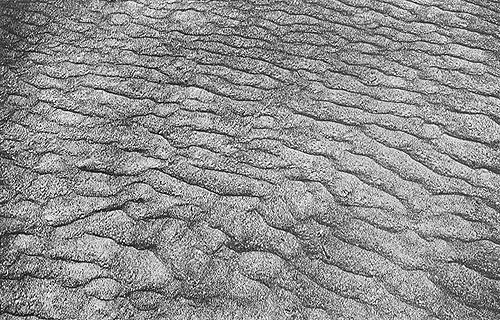
Current ripples in deep water
Plate 32

Current ripples in deep water
Plate 32
This photo was shot by a subaqueous camera towed by a ship, at a depth of about 300 m in the Sicily Channel, Mediterranean Sea. There is no scale, but the coarse texture of the material (sand and small pebbles, probably) is evident. Asymmetrical ripples (or megaripples, which are roughly equivalent to dunes in size) were made by a current whose direction can be detected by the position of the slipface. Waves, on the other hand, are not capable of moving sand and pebbles at this depth.
In an inland sea like the Mediterranean, the bottom topography and water circulation are quite complex. There are different basins of diverse size and depth, which communicate by means of submarine sills and straits. Lateral and vertical confinement of water masses can occur, which induce local acceleration of currents; these currents are created by surface winds, pressure gradients, and water exchanges between basins with different hydrological balances (the eastern Mediterranean, for example, is subject to strong evaporation and draws water from the western part). Tides and global circulation, on the other hand, are rather ineffective.
Whatever its origin, a current exerting a mechanical action on sediment on the deep-sea bed (by deep I mean "beyond the shelf edge") is called a bottom current, which is a convenient descriptive term. A bottom current can be sufficiently strong as to drag coarse particles; if it is weaker, only mud can be carried in suspension. A tractive bottom current is a typical selective agent; it separates sand from mud leaving beds of "clean," sorted to well-sorted sand. If terrigenous material is not available, the sand can be made of organic remains (calcareous or siliceous). Bottom currents generally flow along the contour lines of the sea bottom, and are also called contour currents. Their deposits, regardless of grain size, are consequently named contourites (see also plate 26).
| Photo: Institute for Marine Geology, C.N.R. 1992. |